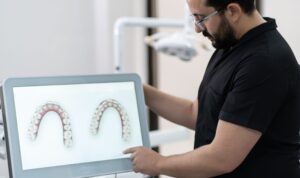
Clear aligner treatment has revolutionized orthodontic care, offering a modern, discreet way to straighten teeth.
But how are these custom-made clear aligners created?
The process relies on advanced technology, starting with digital scans and ending with perfectly tailored aligners designed for each patient.
In this article, we’ll take you through the step-by-step process of how clear aligners are made.
 The process begins with digital scanning, where orthodontists use advanced intraoral scanners to capture precise 3D images of a patient’s teeth and gums.
The process begins with digital scanning, where orthodontists use advanced intraoral scanners to capture precise 3D images of a patient’s teeth and gums.
Digital scans are superior to traditional impressions, which require messy molds and can be uncomfortable.
With a digital scan, the orthodontist glides a small, handheld device over the patient’s teeth, instantly generating a detailed, 3D representation on a computer screen.
This precise digital image serves as the foundation for designing the treatment plan and fabrication process.
Once the digital scans are complete, the orthodontist uses specialized software to create a detailed treatment plan. This plan maps out every stage of tooth movement from the starting position to the desired alignment.
This stage is crucial for creating a custom treatment plan that ensures best results for each patient. The software simulates how the teeth will gradually shift into place over time, creating a step-by-step roadmap.
Patients can even preview their future smile before starting treatment, which helps them stay motivated throughout the process.
This stage ensures that the aligners are not only effective but also precise in achieving the patient’s goals.
Once the treatment plan is finalized, the design moves to the 3D modeling stage to create clear aligners. Advanced 3D printers create physical molds for each step of the treatment plan.
The 3D printer produces high-precision molds that correspond to the incremental movements of the teeth. These molds are the foundation for fabricating the clear aligners.
3D printing is a crucial step in transforming digital plans into physical molds.
 With the 3D-printed molds ready, the actual aligners are fabricated. Medical-grade, BPA-free plastic is used to create the aligners, ensuring they are safe and comfortable to wear.
With the 3D-printed molds ready, the actual aligners are fabricated. Medical-grade, BPA-free plastic is used to create the aligners, ensuring they are safe and comfortable to wear.
The plastic is heated and thermoformed over each mold, taking on its shape to match the precise tooth position, facilitating effective orthodontic tooth movement. Afterward, the aligners go through a trimming and polishing process to ensure smooth edges and a comfortable fit.
The result is a set of clear aligners that are durable, comfortable, and customized to gently shift teeth into proper alignment.
Laser marking and trimming are crucial steps in the clear aligner manufacturing process, ensuring each aligner is both identifiable and comfortable for the patient.
Once the aligners pass quality control, they are packaged according to the patient’s treatment plan. Each set is labeled and organized in the correct order to ensure the patient receives them in sequence, which is crucial for the treatment process.
Aligners are either sent to the orthodontist’s office or shipped directly to the patient, depending on the treatment provider. Patients also receive detailed instructions on how to wear, clean, and store their aligners.
Clear aligners are made from advanced materials carefully chosen for their unique properties, ensuring both effectiveness and comfort during orthodontic treatment.
The most frequently used materials for clear aligners are thermoplastic polymers, such as:
These materials are lightweight, transparent, and comfortable, making them ideal for creating clear aligners that fit snugly and discreetly.
Other materials used in clear aligner fabrication include:
Each of these materials offers unique benefits, allowing orthodontists to tailor clear aligners to the patient’s specific needs.
 Advances in material science are constantly improving the functionality and efficiency of clear aligners:
Advances in material science are constantly improving the functionality and efficiency of clear aligners:
Clear aligner materials are meticulously chosen for their strength, durability, and comfort, which are critical for effective orthodontic treatment.
The mechanical properties of clear aligner materials, such as strength, stiffness, and elasticity, directly influence their clinical performance.
The short answer is no, you should not attempt to make your own aligners. While it may seem tempting to create a DIY solution for misaligned teeth, clear aligners require advanced technology, precise materials, and professional expertise to be both safe and effective.
Clear aligners are custom-made based on detailed digital scans and treatment plans created by orthodontic professionals. Attempting to make aligners at home can lead to several problems:
![]() The advanced technology behind clear aligner production offers several advantages over traditional methods:
The advanced technology behind clear aligner production offers several advantages over traditional methods:
This modern approach combines accuracy and convenience, making clear aligners a popular choice for orthodontic treatment.
Unlike traditional metal braces, which require regular adjustments to guide teeth, clear aligners apply gradual pressure to achieve the desired results.
The process of creating clear aligners, from digital scans to 3D modeling, is a perfect blend of cutting-edge technology and personalized care. Each step is designed to ensure that aligners are precise, effective, and comfortable.
At Smilebliss, we specialize in providing orthodontic solutions tailored to your needs. If you’re ready to achieve a straighter smile with advanced orthodontic treatment, contact us today.
Schedule a consultation and take the first step toward your beautiful smile!